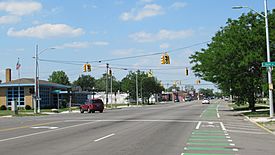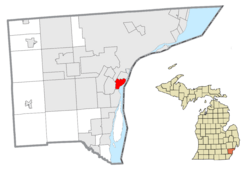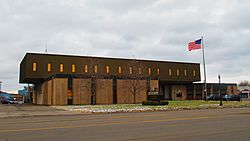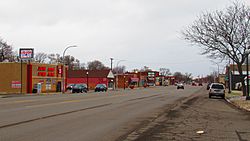Ecorse, Michigan facts for kids
Quick facts for kids
Ecorse, Michigan
|
|
|---|---|
| City of Ecorse | |

Intersection of Outer Drive and Jefferson Avenue
|
|

Location within Wayne County
|
|
| Country | |
| State | |
| County | Wayne |
| Incorporated | 1903 (village) 1942 (city) |
| Government | |
| • Type | Mayor–council |
| Area | |
| • City | 3.71 sq mi (9.62 km2) |
| • Land | 2.84 sq mi (7.35 km2) |
| • Water | 0.88 sq mi (2.27 km2) |
| Elevation | 581 ft (177 m) |
| Population
(2020)
|
|
| • City | 9,305 |
| • Density | 3,279.87/sq mi (1,266.35/km2) |
| • Metro | 4,285,832 (Metro Detroit) |
| Time zone | UTC-5 (EST) |
| • Summer (DST) | UTC-4 (EDT) |
| ZIP code(s) |
48218 (River Rouge)
48229 |
| Area code(s) | 313 |
| FIPS code | 26-24740 |
| GNIS feature ID | 0625337 |
Ecorse (pronounced EE-korrss) is a city in Wayne County, Michigan. It is a part of the Downriver area within Metro Detroit. The city is located along the Detroit River.
In 2010, about 9,512 people lived in Ecorse. The city shares its name with the Ecorse River. This river forms its southern border with the city of Wyandotte. The Detroit River forms Ecorse's eastern border. This border is also part of the Canada–United States border with LaSalle, Ontario.
Contents
What's in a Name? The Story of Ecorse
Native American tribes once used this area as a burial ground. When French settlers arrived in the late 1700s, they named a nearby waterway "Rivière Aux Échorches." This French name means "The River of the Barks" in English. This is where the name Ecorse comes from.
A Look Back: Ecorse's History
In 1836, after the area became part of the United States, more English speakers settled here. They called the community Grand Port. It was part of Ecorse Township.
In 1903, Grand Port became an official village named Ecorse. A big change happened in 1923 when the first steel mill, Michigan Steel Mill, opened. This helped Ecorse become an important economic center. The village officially became a city in 1942.
Like many industrial cities, Ecorse has faced economic challenges over time. The city has worked hard to improve its financial situation. In 2009, the state of Michigan helped Ecorse manage its finances. By 2013, the city moved to a state advisory board. This board continues to help Ecorse with its financial planning.
Where is Ecorse? Its Geography
Ecorse covers about 3.69 square miles (9.6 square kilometers). Most of this area is land, about 2.80 square miles (7.3 square kilometers). The rest, about 0.89 square miles (2.3 square kilometers), is water.
The Detroit River forms the city's eastern edge. The Ecorse River marks its southern boundary. Mud Island is located within the Detroit River. It is part of Ecorse and is included in the Detroit River International Wildlife Refuge.
Learning in Ecorse: Schools and Library
Schools for Students
Ecorse Public Schools runs the public schools in the city.
- Ralph J. Bunche School serves students from Pre-Kindergarten to 3rd grade.
- Grandport Elementary School is for students in grades 4-7.
- Ecorse Community High School teaches students from 8th to 12th grade.
- Project Excel is a special magnet school for grades 3-8.
The Ecorse Public Library
The Ecorse Public Library is a great place to find books and learn. It was designed to be fireproof by architects Bennett and Straight.
Library services first started in Ecorse in 1922. A small collection of books was placed at Loveland's Pharmacy. In 1926, the library got its own space with 600 books. The current Ecorse Public Library building opened on December 12, 1948. It cost $150,000 to build. The American Library Association even named it one of the best small libraries in the United States!
Fun and Games: Parks and Recreation
Ecorse offers places for fun and relaxation.
- The city has a Senior Center for older residents.
- There is also a rowing club for those who enjoy water sports.
- John D. Dingell Park is a lovely park located along the Detroit River. It's a great spot to enjoy the waterfront.
Who Lives in Ecorse? Population Facts
In 2010, Ecorse had 9,512 people living in 3,646 homes. About 27.1% of residents were under 18 years old. The average age in Ecorse was 35.4 years.
The city's population is diverse. In 2010, about 46.4% of residents were African American. About 44.0% were White. People of Hispanic or Latino background made up 13.4% of the population.
See also
 In Spanish: Ecorse (Míchigan) para niños
In Spanish: Ecorse (Míchigan) para niños





